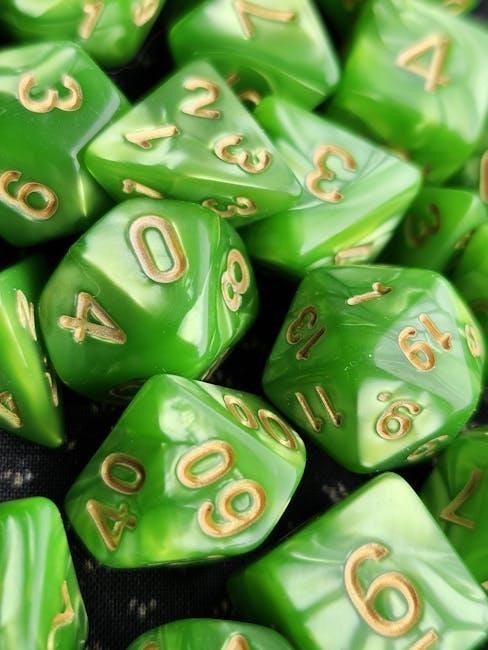dungeons dragons 4e pdf
Category : PDF
Dungeons & Dragons 4th Edition, released in 2008, introduced a tactical combat system and robust character customization․ It balanced complexity and accessibility, appealing to both newcomers and veteran players․ This edition emphasized structured gameplay and digital tools, setting a foundation for modern D&D․
Overview of D&D 4th Edition
Dungeons & Dragons 4th Edition, released between 2008 and 2014, introduced a refined tactical combat system, emphasizing miniatures and battle mats․ It streamlined rules, offering structured character progression and powers․ The edition balanced complexity with accessibility, appealing to both veterans and newcomers․ While official PDFs are no longer sold, platforms like DMs Guild and DriveThroughRPG provide access to 4th Edition materials, ensuring its legacy endures among enthusiasts․ Digital tools like D&D Beyond and third-party apps support gameplay, making it easier to create characters and manage campaigns․ This edition remains a cornerstone of D&D’s evolution, blending strategic depth with storytelling․
Release and Key Features
Dungeons & Dragons 4th Edition was officially released in 2008, marking a significant evolution in gameplay mechanics․ It introduced a tactical combat system, emphasizing miniatures and battle mats for strategic encounters․ The edition featured streamlined rules, structured character progression, and powers tied to specific classes․ The core rulebooks—Player’s Handbook, Dungeon Master’s Guide, and Monster Manual—provided detailed frameworks for players and Dungeon Masters․ Key innovations included the use of healing surges, encounter-based resource management, and a focus on balanced party roles․ While official 4th Edition PDFs are no longer sold, platforms like DMs Guild and DriveThroughRPG offer access to digital copies, ensuring its legacy among D&D enthusiasts․
Differences from Other Editions
D&D 4th Edition stands out for its tactical combat system, emphasizing miniatures and grid-based battles, unlike earlier editions․ It introduced structured class progression with powers tied to specific roles, fostering balanced party dynamics․ The system moved away from the complexity of 3․5e, offering streamlined rules and encounter-based resource management․ Unlike 5th Edition, 4th Edition focused on mechanical depth over narrative flexibility․ The edition also introduced healing surges, a unique mechanic for character sustainability․ While 5th Edition leaned into cinematic storytelling, 4th Edition catered to tactical strategists․ Its rigid structure and focus on combat distinguish it from other editions, appealing to fans of battlefield precision and strategic gameplay․

Core Rulebooks of D&D 4th Edition
The core rulebooks include the Player’s Handbook, Dungeon Master’s Guide, and Monster Manual․ These essential books provide rules, character options, and tools for players and DMs․
Player’s Handbook
The Player’s Handbook is the cornerstone of D&D 4th Edition, offering essential rules and options for creating and advancing characters․ It details races, classes, and character builds, providing players with the tools to craft unique personalities and abilities․ The book includes extensive lists of feats, skills, and equipment, enabling players to customize their characters for diverse playstyles․ Additionally, it covers basic game mechanics, such as ability scores, level progression, and combat roles․ The Player’s Handbook is a must-have for anyone new to D&D 4th Edition, as it lays the groundwork for character creation and gameplay․ Official PDF versions are available through platforms like DMs Guild and DriveThroughRPG, ensuring easy access to this fundamental resource․
Dungeon Master’s Guide
The Dungeon Master’s Guide (DMG) is an indispensable resource for DMs in D&D 4th Edition, packed with tools to craft compelling adventures and manage gameplay․ It includes detailed guidance on world-building, NPC creation, and treasure design, along with optional rules to customize campaigns․ The DMG also features extensive lists of magic items, rituals, and artifacts, enhancing the depth of the game․ DMs can find tips on encounter design, balancing challenges, and creating dynamic combat scenarios․ Additionally, it provides resources for integrating monsters from the Monster Manual into unique and engaging storylines․ Official PDF versions of the DMG are available on platforms like DMs Guild, offering convenient access to this essential D&D 4th Edition resource․
Monster Manual
The Monster Manual is a cornerstone of D&D 4th Edition, serving as a comprehensive guide to creatures, enemies, and allies․ It details stats, abilities, and roles for hundreds of monsters, from iconic beasts like dragons and liches to unique entities․ Each entry includes tactical notes for DMs to integrate monsters into encounters seamlessly․ The manual categorizes creatures by role (e․g․, brute, lurker, skirmisher) and level, helping DMs balance combat․ It also explores monster lore, behaviors, and habitats, enriching the game world․ The Monster Manual is essential for DMs seeking to populate their campaigns with diverse and engaging foes․ Official PDFs are available on platforms like DMs Guild, ensuring easy access to this vital resource․

Where to Buy Official D&D 4th Edition PDFs
Official D&D 4th Edition PDFs are available through DMs Guild and other authorized platforms like DriveThroughRPG․ These sites offer a wide range of 4E content legally․
DMs Guild and Official Sources
The DMs Guild is the primary platform for purchasing official D&D 4th Edition PDFs, offering a vast library of content, including core rulebooks and supplements․ As an official Wizards of the Coast partner, it ensures authenticity and quality․ Purchasing from DMs Guild directly supports content creators and the broader D&D community․ Additionally, official sources like the D&D Beyond and the official D&D website provide access to 4th Edition materials․ These platforms are trusted for their legitimacy and often feature exclusive content, making them the go-to destinations for fans․ Buying from these sources guarantees you receive high-quality, legally licensed PDFs, free from piracy concerns․ Always prioritize official channels to support the game’s future development and maintain its legacy․
DriveThroughRPG and Other Platforms
DriveThroughRPG is a popular platform for purchasing digital copies of D&D 4th Edition PDFs, offering a wide range of official and third-party content․ It provides easy access to core rulebooks, supplements, and adventures in digital format․ While it may not exclusively host D&D content, it remains a reliable source for older editions․ Additionally, other platforms like itch․io and independent seller websites may offer D&D 4th Edition PDFs, though these often include community-created or third-party material․ When using these platforms, ensure you verify the seller’s legitimacy to avoid unauthorized or pirated content․ Purchasing from reputable sources supports both the creators and the tabletop gaming community․
Importance of Purchasing Legal Copies
Purchasing legal copies of D&D 4th Edition PDFs is crucial for supporting the creators and maintaining the quality of the game․ Legal copies ensure that the content is free from viruses, poorly formatted text, and unauthorized alterations that are common in pirated versions․ By buying legitimate copies, you contribute to the sustainability of the tabletop gaming industry and encourage the creation of future content․ Additionally, legal copies often include access to official updates, errata, and digital tools that enhance gameplay․ Supporting official sources also helps protect intellectual property rights, fostering a healthy and innovative community․ Investing in legal copies is a commitment to the game’s legacy and the enjoyment of players worldwide․

Character Creation in D&D 4th Edition

Character creation in D&D 4th Edition offers deep customization, with classes, races, and backgrounds shaping unique heroes, encouraging creativity and strategic optimization․
Classes and Roles
D&D 4th Edition introduces a structured class system, dividing characters into distinct roles: Controllers, Defenders, Leaders, and Strikers․ Each class fulfills a specific function within a party, ensuring balanced gameplay․ Controllers, like Wizards, manage battlefield dynamics, while Defenders, such as Fighters, protect allies․ Leaders, including Clerics, support and heal, and Strikers, like Rogues, deal high damage․ Classes also have access to unique powers, such as encounter, daily, and at-will abilities, offering tactical depth․ Role diversity encourages teamwork and strategic planning․ Players can choose from iconic classes like Warlords or Warlocks, each with unique mechanics․ This system promotes synergy and specialization, making character creation both intuitive and rewarding․
Races and Backgrounds
D&D 4th Edition offers a wide variety of races, each with unique racial traits and abilities․ Players can choose from iconic races like Humans, Dwarves, Elves, and Halflings, as well as more exotic options such as Dragonborn and Tieflings․ Each race provides distinct benefits, such as bonus stats, skill proficiencies, or special powers․ Additionally, backgrounds introduce a new layer of customization, allowing players to define their character’s history and personality․ Backgrounds grant specific skills, languages, or equipment, adding depth to a character’s story and roleplaying potential․ Together, races and backgrounds create a rich foundation for character identity, enabling players to craft unique personalities and histories that shape their adventures․
Character Builds and Optimization
Character builds in D&D 4th Edition are a combination of race, class, and feat selections designed to maximize effectiveness․ Players can choose from a wide array of feats, which provide specific enhancements to abilities, combat prowess, or utility․ Optimization focuses on selecting powers, equipment, and traits that synergize with the character’s role in the party․ The system encourages strategic planning, allowing players to tailor their characters for specific playstyles, such as damage dealing, tanking, or support․ The use of party roles (leader, striker, controller, defender) helps guide build decisions, ensuring each character contributes effectively to the group’s success․ Resources like the Character Builder tool simplify the process of creating and optimizing builds․
Combat Mechanics in D&D 4th Edition
D&D 4th Edition features tactical, grid-based combat with miniatures․ Powers, abilities, and role synergy define engagements․ d20 rolls resolve attacks, skills, and damage, emphasizing strategy and encounter balance․

Combat System Overview
D&D 4th Edition’s combat system is highly structured and tactical, emphasizing grid-based movement and miniatures․ Combat revolves around the d20 system, where rolls determine hits, damage, and skill checks․ Each round is divided into turns, with creatures and characters acting in initiative order․ The system introduces standardized rules for movement, attack types, and special abilities, ensuring clarity and balance․ Players and DMs alike must strategically plan actions, leveraging class powers and environmental factors․ This predictability allows for complex encounters while maintaining fairness․ The combat mechanics are detailed yet accessible, making D&D 4th Edition a robust system for both newcomers and veterans seeking depth in their battles․
Powers and Abilities
D&D 4th Edition introduced a structured system for powers and abilities, defining how classes utilize their unique talents․ Each class has access to specific types of powers: At-Will, Encounter, and Daily, which vary in frequency and potency․ At-Will powers can be used indefinitely, while Encounter powers recharge after a short rest․ Daily powers are the most powerful but can only be used once per day․ This system allows for strategic planning and resource management during combat․ Players can also customize their abilities through Feats and Paragon Paths, enabling deeper character specialization․ The emphasis on standardized power mechanics ensures balance while fostering creativity in character development and tactical combat․
Encounter Design and Tactics
D&D 4th Edition emphasizes structured encounter design, balancing challenge and fun․ Encounters are built using monsters with specific roles: Controllers, Strikers, and Soldiers, ensuring diverse combat dynamics․ The Dungeon Master’s Guide provides formulas to calculate encounter difficulty based on party level and size, ensuring balanced challenges․ Tactical depth is enhanced by unique monster abilities and environmental interactions, encouraging players to adapt strategies․ Terrain, hazards, and elevation play significant roles, adding layers of complexity; Players must coordinate and utilize their powers effectively, while the DM must anticipate and respond to party tactics․ This system fosters engaging, dynamic combat experiences, blending strategy with creativity for both players and DMs․

The Role of the Dungeon Master
The Dungeon Master crafts immersive stories, adjudicates rules, and manages gameplay, ensuring a balanced and engaging experience for players while maintaining the flow of the adventure․
Preparing Adventures
Preparing adventures is a cornerstone of the Dungeon Master’s role in D&D 4th Edition․ This involves crafting compelling stories, designing balanced encounters, and creating immersive environments that align with the players’ choices and abilities․ The DM must also develop non-playable characters (NPCs) with distinct personalities and motivations to enrich the narrative․ Additionally, they prepare maps, puzzles, and challenges that cater to the party’s strengths and weaknesses․ A well-prepared adventure ensures smooth gameplay and engages players on multiple levels, fostering creativity and collaboration․ The DM’s ability to adapt their preparations to the players’ decisions is key to delivering a dynamic and memorable experience․
- Developing story arcs and quests․
- Designing encounters with appropriate challenges․
- Creating detailed NPCs and environments․
- Ensuring gameplay balance and player engagement․
Running Combat Encounters
Running combat encounters in D&D 4th Edition requires careful management of the battle’s flow, ensuring each player’s turn is handled efficiently․ The DM must maintain initiative order, track hit points, and describe the scene vividly to immerse players․ They also control monsters, using their abilities strategically to challenge the party․ Effective communication and adaptability are crucial, as the DM must respond to players’ actions and decisions․ Additionally, the DM uses terrain and environmental effects to enhance the encounter’s complexity and excitement․ Balancing difficulty and fun ensures a rewarding experience for all players․
- Maintaining initiative and tracking combat flow․
- Managing monster tactics and abilities․
- Using descriptive language to enhance immersion․
- Adapting to players’ decisions and actions․
World-Building and Storytelling
World-building and storytelling are cornerstone elements of D&D 4th Edition, allowing the DM to craft immersive and engaging experiences․ A well-designed world provides depth, lore, and context for adventures, making the game more meaningful․ The DM creates vibrant settings, from bustling cities to ancient ruins, each with unique themes and histories․ Storytelling weaves these elements together, presenting players with compelling narratives, moral dilemmas, and character arcs․ The DM must balance player agency with a structured plot, ensuring the story evolves organically․ Rich NPCs, quests, and factions further enrich the world, creating a dynamic and interactive environment․
- Designing detailed settings and lore․
- Developing engaging narratives and NPCs․
- Integrating player choices into the story․
- Creating immersive and dynamic environments․
Digital Tools and Resources
D&D 4th Edition players and DMs can utilize digital tools like D&D Beyond, Fantasy Grounds, and Roll20 for rules databases, virtual battle mats, and character builders․
- D&D Beyond offers comprehensive rules and character tools․
- Fantasy Grounds provides virtual tabletop solutions․
- Roll20 enhances online gameplay experiences․
D&D Beyond and Official Digital Tools
D&D Beyond is the official digital platform for Dungeons & Dragons, offering comprehensive resources for 4th Edition players and DMs․ It provides access to official 4e PDFs, including the Player’s Handbook, Dungeon Master’s Guide, and Monster Manual․ The platform features a searchable rules database, character builder, and digital dice roller․ Official tools enhance gameplay by streamlining rule lookups and character management․ Purchasing official PDFs ensures access to accurate and updated content, supporting Wizards of the Coast․ D&D Beyond also offers a clean reading experience and easy navigation, making it a valuable resource for both new and veteran players․ Its official status guarantees compatibility with other D&D 4e materials, ensuring a seamless gaming experience․
Third-Party Software and Apps
Beyond official platforms, third-party software and apps offer additional tools for enhancing Dungeons & Dragons 4th Edition gameplay․ Programs like Roll20 and Fantasy Grounds provide virtual tabletop experiences, enabling online play and digital character management․ Apps such as D&D Beyond alternatives, like Fight Club 5th Edition, can assist with rule references and character building․ These tools often integrate with official 4e PDFs, allowing players and DMs to access content seamlessly․ While not officially endorsed, these resources are popular for their convenience and customization options․ However, always ensure that third-party tools comply with Wizards of the Coast’s policies and support the use of legally purchased materials to maintain game integrity and legality․
Online Communities and Forums
Online communities and forums dedicated to Dungeons & Dragons 4th Edition are vibrant hubs for players and Dungeon Masters․ Platforms like Reddit’s r/LFG and r/4e, as well as official D&D forums, host discussions on gameplay, character builds, and rule interpretations․ These spaces allow players to share homebrew content, seek advice, and collaborate on campaigns․ Fans often exchange tips for optimizing classes and races, while DMs showcase their custom adventures․ Communities like EN World and The Piazza also provide extensive resources and archives for 4e enthusiasts․ These forums foster camaraderie and creativity, ensuring that the legacy of 4th Edition remains alive and thriving among its dedicated fanbase․

Community and Fan Content
The 4e community is known for its creativity, with fans creating custom adventures, homebrew rules, and sharing resources․ This dedication keeps the game vibrant and evolving․
Fan-Made Adventures and Modules
Fan-made adventures and modules for D&D 4e are a testament to the community’s creativity․ Players and DMs collaborate to craft unique quests, often inspired by official campaigns but with fresh twists․ These creations range from short, bite-sized encounters to epic, multi-level adventures․ Many fans share their work as free PDFs online, offering diverse settings, from high-fantasy realms to dark, gritty worlds․ Some modules even adapt popular stories or video games into the 4e framework․ These resources are easily accessible on platforms like the DMs Guild or community forums, making it simple for players to expand their gameplay․ The dedication of fans ensures that 4e remains vibrant, with new content constantly emerging to suit every playstyle․
Homebrew Rules and Variants
Homebrew rules and variants are a cornerstone of the D&D 4e community, showcasing the game’s flexibility․ Players and DMs often create custom content, from balanced tweaks to entirely new mechanics․ These modifications can streamline gameplay, introduce fresh dynamics, or cater to specific playstyles․ Variants might include alternate class builds, custom races, or experimental rules for magic or combat․ Fans share their creations through forums, blogs, and PDFs, fostering a culture of innovation․ While not officially endorsed, these homebrew additions are widely embraced, offering endless possibilities for customization․ The community’s collaborative spirit ensures that D&D 4e remains dynamic and evolving, even years after its release․
Community-Driven Projects
Community-driven projects are a vital part of the Dungeons & Dragons 4th Edition ecosystem, showcasing the creativity and dedication of its fanbase․ These collaborative efforts range from custom adventures, original character classes, and comprehensive rule expansions to entirely new campaign settings, all crafted by passionate enthusiasts․ Platforms like DMs Guild and online forums serve as hubs for these ventures, allowing creators to share, receive feedback, and refine their work․ What distinguishes these projects is their democratic nature—anyone can contribute, fostering a sense of ownership and innovation․ By continually introducing new content, the community ensures that D&D 4e remains dynamic and engaging․ These projects not only extend the game’s lifespan but also strengthen the bonds within the player base, proving that the true spirit of D&D lies in shared creativity and collaboration․
Legacy and Impact of D&D 4th Edition
D&D 4th Edition revolutionized the RPG landscape with its tactical combat and structured rules, influencing modern D&D and fostering a dedicated community of players and creators․
Influence on Modern D&D

D&D 4th Edition’s structured ruleset and tactical combat system significantly influenced modern D&D, particularly in 5th Edition’s class design and encounter balancing․ The emphasis on miniatures and grid-based combat from 4e carried over, enhancing strategic gameplay․ The concept of powers and abilities introduced in 4e laid the groundwork for 5e’s class feature progression․ Additionally, 4e’s focus on balanced party roles shaped how 5e classes interact in combat․ The digital tools and organized rule presentation from 4e also inspired platforms like D&D Beyond․ While 5e adopted a more flexible approach, the foundational innovations of 4e remain evident, ensuring its legacy as a bridge between earlier editions and modern gameplay․
Reception and Criticism
D&D 4th Edition received mixed reviews upon its 2008 release․ Fans praised its tactical combat system, structured rules, and class balance, which appealed to strategy enthusiasts and newcomers alike․ The game’s miniatures-focused design and grid-based combat were seen as innovative, offering depth and visual engagement․ However, critics argued that the system felt too rigid and video game-like, alienating fans of older editions who preferred storytelling over mechanical complexity․ The emphasis on powers and abilities was criticized for limiting role-playing flexibility․ Despite initial popularity, the edition’s market share declined over time, leading Wizards of the Coast to revisit their approach in later editions․ The divided reception highlights the challenges of evolving a beloved game while maintaining its core appeal․

Future of D&D 4th Edition
While Dungeons & Dragons 4th Edition is no longer the flagship version, it maintains a dedicated fan base and occasional support․ Wizards of the Coast has shifted focus to 5th Edition, but 4th Edition content remains accessible through digital platforms like D&D Beyond and DMs Guild․ The community continues to create homebrew material, ensuring the edition’s longevity․ Its influence is evident in modern D&D’s tactical combat and class design․ Though official updates are rare, 4th Edition’s structured ruleset and strategic depth keep it relevant for players seeking a more mechanized experience․ Its legacy endures as a bridge between earlier editions and contemporary D&D, offering a unique playstyle for those who appreciate its complexity and balance․
